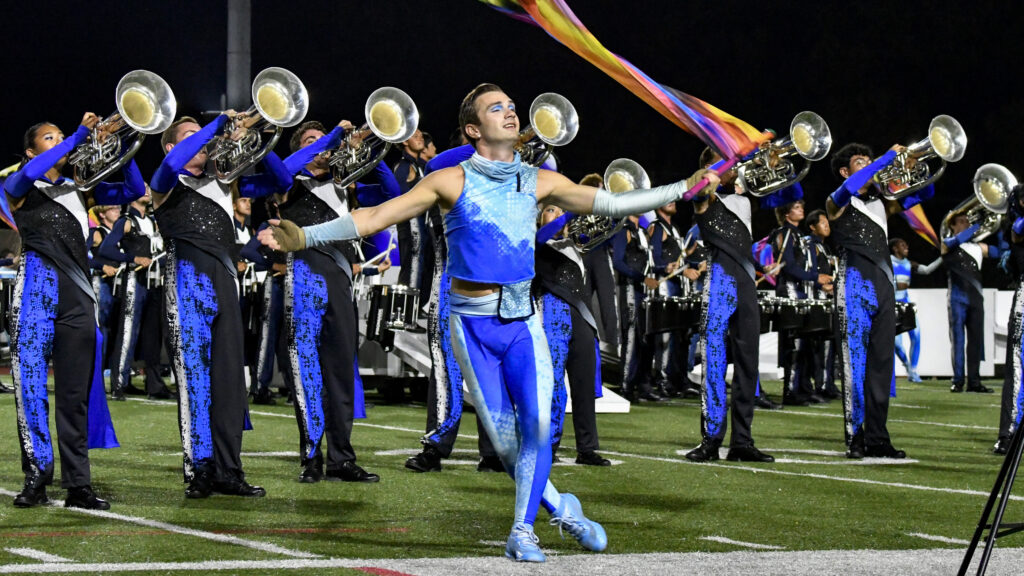This summer marks the 20th anniversary of the summer that DCI Hall of Famers Donnie VanDoren (brass instructor) and Jim Prime (brass arranger and instructor) flew out to Casper, Wyo., at the special request of legendary Troopers founder Jim Jones to instruct that corps. The two took a very young and inexperienced corps and lead it to ninth place. The summer before, Prime and VanDoren helped bring the Garfield Cadets to a World Championship with an innovative reading of “West Side Story.”

Jim Prime Jr. began marching at the tender age of 9 and has been heavily involved ever since. Prime’s life is a great blueprint for all you young people who aspire to live and work in the drum corps atmosphere. During the DCI Winter meetings last month in Orlando, Fla., DCI.org’s Mike Boo sat down with the legendary arranger for a “history lesson.” The following are Prime’s own words: I certainly have a history in drum corps. I grew up in drum corps and it made quite an impression on me from my youth. The life lessons it taught me not only sustained me through any difficulties and tough decisions, but also was a cornerstone to building success in life in terms of family, faith and certainly my career. Those habits of work ethic and persistently pursuing the goal have always been significant to my success as an arranger and teacher. I think in the drum corps activity, a young person learns that their role as a performer influences someone else’s role as a performer. All elements of the group are interdependent. The importance of the individual’s responsibility to the group is emphasized in an activity like drum corps, where that interdependence is the driving force for that individual’s success. Probably the one aspect of drum corps that I refer to as an adult more and more is the attention to detail that I learned at a very young age through this activity. As a teacher, I’ve always tried to impact that significance upon my students. Drum corps as an activity is a great vehicle because excellence in that area translates to success that is easily recognized. That is not the case in too many activities for young people. My father, Jim Prime, Sr., was my most influential teacher growing up. He arranged the music for our local drum corps, the Chessmen (of Easton, Pa.), so I was around my teacher not only during rehearsals, but also when the product was being produced. I got to understand what went on during the creative process. I got to understand that one hour during the production process could influence hours in the learning process, thus the emphasis for me regarding care and attention was highlighted when I became an arranger. I played baritone for the Chessman when I was 9. I was a diehard member. I loved rehearsing and improving. I was the type that was enthralled by the details in perfect execution. I marched Chessmen for eight years, then marched in the Hawthorne Muchachos in 1973 and 1975. As a drum corps fan in the 1960s, I would literally listen to recordings hundreds of times, over and over again. I was in awe of the top corps. I became so inspired. I can remember clearly to this day the first major contest I went to in 1966. That was the year the Midwest and Western corps came east to the National Dream contest. The first corps on that afternoon was the Cavaliers and the first sounds I heard was their opener of “Bully,” arranged by Sal Ferrara. It was the most amazing sound I heard in drum corps and it opened my mind to a whole new realm of musical possibilities. Three corps later the Troopers were on, and another realm of visual possibilities opened up. I went to an event and saw two revolutionary things at the same event. I loved Santa Clara from when I first saw them in 1970. Gail Royer’s arrangements were constantly setting new standards. It was at that point that I came to realize that the arranging style had so much to do with the sound. In subsequent years, my notion was taken a step farther when Blue Devils delivered such sheer presence and projection in 1976. They were overwhelming in their power and quality. That started a number of years when they overpowered the activity. Setting the stage for my ambition to somehow created a different sound and through utilizing Donnie VanDoren’s unique brass ensemble approach, the sound of the 1980s Garfield Cadets was born. Donnie and I had taught Crossmen as assistants in 1979. In 1980, Garfield had that kind of show that different arrangers contributed to, and George Hopkins needed some revisions to the charts and I was allowed to do the revisions. Following that, they allowed me to write the concert number. In 1981, I started writing the whole book for Garfield. 1982 was the year Garfield tried to stretch the boundaries. The show was built on an attempt to be seamless. The show was formatted in a different manner than people were accustomed. Motion and visual became a mutual driving force for the music selection and arranging. George Zingali came on board to write the drill and his genius and our respect for his creative ability to interpret the music provided the impetus for visual and music to have a mutual partnership. There was much more to come for me; including two more years with Garfield and a year (1985) with Troopers during a time I was not going to do drum corps. But Jim Jones called me and I couldn’t turn him down because I had been a fan of Troopers from my youth. In 1986 I went to Star of Indiana and stayed until the corps’ last year in 1993. “Brass Theater” and “Blast!” followed. I wrote for Ventures in the middle 1980s, arranged for the Blue Knights from 1990-1992, the Boston Crusaders from 1993-1994 and I’ve for written for two Championship DCA corps, the Sunrisers for four years in the 1980s and Hawthorne Caballeros for two years in the 1990s. I’m in my 25th year of teaching elementary instrumental music in Elizabeth, N.J. I enjoy and appreciate it more now than I ever have, but once again, I’m often reminded of those lessons that I learned as a youth in drum corps and I can honestly say it influences me every day in my teaching. Read Jim Prime Jr.’s bio in the DCI Hall of Fame.





